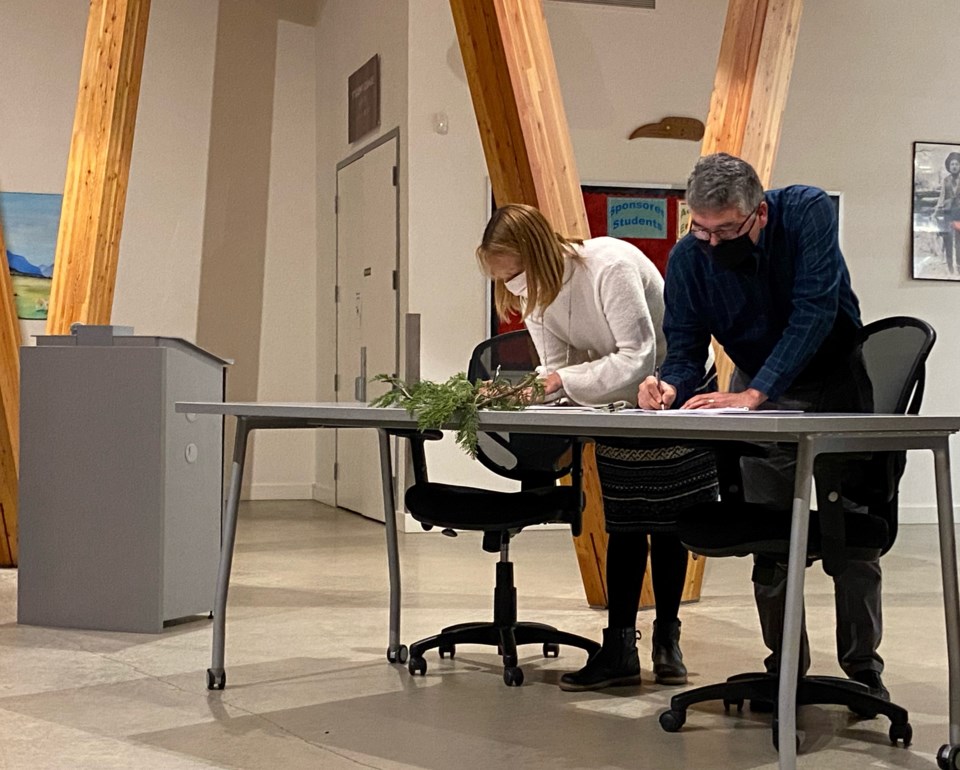A new agreement between the Sea to Sky School District (SD48) and Liĺwat Nation is working to improve educational outcomes for Indigenous students throughout the corridor.
The Local Education Agreement (LEA), signed during a ceremony held at the Ts’zil Learning Centre in Mount Currie on Nov. 18, effectively formalizes the relationship between the public school board and the Nation. As educators continue learning how best to support Indigenous students’ cultural needs in a way that maximizes their opportunities both in and out of the classroom, it also solidifies the Nation’s involvement in educational decisions and serves as an important step on the path toward reconciliation.
“Schools are the example of how oppression was able to occur in history. And this is the most important place to undo that and make sure that people get success and support,” said Karen LaRochelle, SD48’s District Principal of Indigenous Education.
Historically, Indigenous students in B.C. public schools have had lower graduation rates and been over-represented in opportunity-limiting courses like workplace math compared with their non-Indigenous counterparts, she explained.
For Kúkwpi7 Skalúlmecw Liĺwat Nation Chief Dean Nelson—a former teacher himself—shedding light on the true history of this country’s First Nations, through curriculum and initiatives like the new National Day for Truth and Reconciliation in particular, is crucial to understanding and addressing the reasons why Indigenous students have not generally experienced the same rate of success in public classroom settings.
“The hardship of the students needs to be understood,” said Nelson. “What happens under the Indian Act, and … what is it like to be in the reserve system?
“They’re just titles but when you do live under them, then they have their impacts,” he continued. “The residential school is another one that, you know, it’s long gone, but it’s still here and within us. The impacts are still here, and we still carry them and some students have no idea what it is. So just looking at the curriculum together and understanding that is, I think, the key to the partnerships of schools and students.”
The LEA represents one small but positive step in the right direction, Nelson said.
“Relationships have [become] better, but I think they can be even better by understanding what we’ve been put through,” he explained.
“The major step of this education agreement was just having a partnership based on the focus of making positive change—that’s basically what it comes down to.”
The agreement falls in line with a provincial push for Local Education Agreements, which received a $3 million funding boost from the B.C. government in 2019. LaRochelle said SD48 and Liĺwat Nation’s agreement is “an exemplary model” that goes above and beyond existing guidelines for these types of contracts, by clearly defining in-school practises.
The agreement builds off work that has already been underway at the district, LaRochelle continued, by helping local schools meet student needs by personalizing their learning. That can be accomplished through curriculum, instruction and assessment adjustments, as well as accommodating all learning styles and “creating a greater cultural relevance” for Indigenous students, LaRochelle said. The agreement also provides a framework for schools to help prepare students for graduation from an earlier age, meaning “course selection is done very carefully in such a way that students are left leaving school with all the options open to them,” she added.
In practise, this could look like increasing flexibility around schools’ typically strict schedules and tight deadlines, said LaRochelle.
She recalled one dilemma where an Indigenous student needed to take an academic prerequisite course that was only offered during the same block as the school’s Ucwalmícwts language course. As a solution, the student was able to earn the academic credit through project-based learning, while attending the Ucwalmícwts classes.
“That’s a good specific example of how we can break down a colonized practise to be more flexible and allow for a student to fulfill academic requirements for a solid graduation program, but also fit in their culture and language coursework,” said LaRochelle.
The LEA comes following several years of work by stakeholders, including a Local Education Agreement Steering Committee that spent “the better part of one year” co-writing and editing the agreement during a series of lengthy monthly meetings. The committee was comprised of Líĺwat Nation members Yvonne Wallace, Ts’zil Learning Centre director; Helena Edmonds, manager of advance education at Ts’zil Learning Centre; and Verna Stager, Líĺwat Nation’s education director, as well as former SD48 superintendent Lisa McCullough and LaRochelle.
Though the five-year plan “is a living working document that we can make edits to collectively,” said LaRochelle, having the contract signed and finalized “is a really good feeling, especially because of the teamwork that occurred to create it.
“It feels like a really good team and that feels so positive for the future,” she added. “But it also feels like there is a lot of work ahead.”




